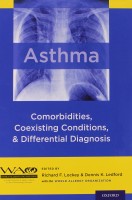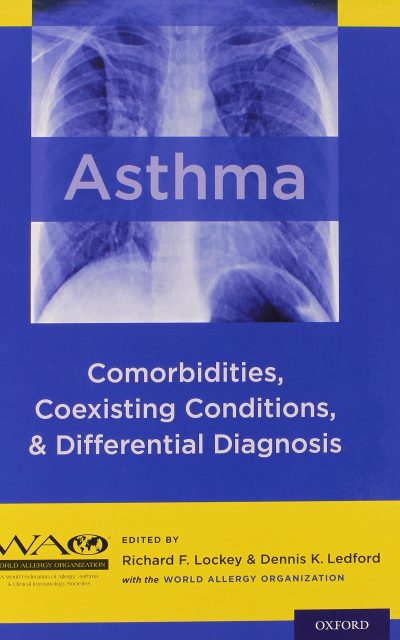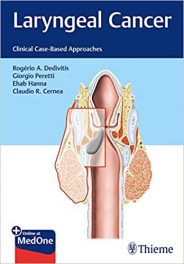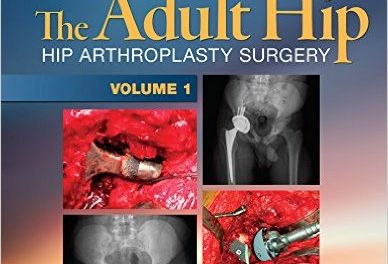 Editors: Richard F. Lockey, MD; and Dennis K. Ledford, MD, with the World Allergy Organization (WAO)
Editors: Richard F. Lockey, MD; and Dennis K. Ledford, MD, with the World Allergy Organization (WAO)
Publisher: Oxford University Press – 481 pages
Book Review by: Nano Khilnani
Globally, an estimated 300 million people suffer from asthma, and the existence of comorbidities is being increasingly recognized in clinical practice as a means to achieve better control, according to Ruby Pawankar, 2013-13 WAO president, and her colleagues Lanny J. Rosenwasser, and Mario Sanchez-Borges, 2012-13 president-elect and secretary general respectively, of that organization, who wrote the Foreword to this book.
They state that this book was developed to become a comprehensive and centralized reference source of information on the diagnosis and management of asthma as it relates to comorbidities and coexisting conditions, which would fill a major gap in the current knowledge and understanding in this particular medical specialty.
This book is useful to you the student or practitioner, also because it:
- Covers the latest research on the theory and practice of asthma
- Provides insights into fundamentals of asthma and its comorbidities
- Discusses the most effective advances in asthma diagnosis and management
- Presents scientifically-based information for multiple comorbid conditions as they relate to: chronic obstructive pulmonary disease (COPD); gastroesophageal reflux disease; endocrine, immunologic, and psychological conditions; obesity; rhinitis; rhinosinusitis; sinusitis; sleep apnea; and vocal cord dysfunction syndrome.
The 2010 WAO International Scientific Conference (WISC) held in Dubai helped build a foundation for the development of this book. But it was really the many collective years of education, training, clinical research, experience, and insight of the doctors – who shared all of these assets plus their valuable time and effort to contribute – that led to the successful compilation for publication of this important book.
Seventy-seven MDs and PhDs from the United States and 16 other countries – Belgium, Canada, Denmark, Finland, Greece, Italy, Japan, Mexico, Poland, Portugal, Russia, South Korea, Spain, Turkey, United Kingdom, and Venezuela – authored the 33 chapters of this book which are organized under the following eleven sections:
- Immunologic
- Pulmonary
- Cardiac and Cardiovascular
- Upper / Extrathoracic Airway
- Gastrointestinal
- Metabolic
- Psychological Issues
- Exercise
- Environmental and Population Effects
- Age
- Food
The editors of this book – Dr. Lockey and Dr. Ledford – have between them more than 75 years of combined clinical and research experience with asthma. And while they write that “asthma is the most treatable of conditions” (a comment they use in lectures to their students, residents, physicians, and other health care professionals), worldwide data from emergency department visits and hospitalizations show that diagnosis and treatment of asthma are not optimal, and need improvement.
What are reasons for the disparity between treatability of asthma and failure to optimize treatment? The editors name four:
- Asthma is not thought of as a complex, heterogeneous disease or syndrome consisting of different phenotypes, defined as “observable properties of an organism that are produced by the interaction of the genotype and the environment,” and endotypes, defined as “conditions characterized by a specific pathobiological process.”
- Asthma is variable, particularly in its severity, and is influenced by known, unknown, avoidable, and unavoidable environmental factors.
- Treatment usually requires complex inhalational devices that are difficult for patients to understand and to use, and with which compliance is suboptimal.
- Assessment of asthma is based primarily on symptoms, and at times all symptoms are due to asthma, but also sometimes some or all symptoms are due to unrecognized and untreated comorbid or coexisting conditions.
The difference between a comorbid condition and a coexisting condition is essentially this: a comorbid condition and asthma influence each other. A coexisting condition on the other hand typically does not influence the condition of the asthma in a patient. Sometimes it is difficult to differentiate a comorbidity from a coexisting condition. This is why asthma is described as “a complex heterogeneous disease or syndrome.”
Asthma is exacerbated when it is not appropriately diagnosed and treated. It is often not adequately treated because of acute or chronic sinusitis. Also, control of asthma is sometimes inadequately assessed because symptoms, and even lung function. The symptoms can be influenced by both asthma on the one hand and by comorbid and coexisting conditions.
So what is the best course of action for a physician, in view of such inadequate diagnosis and multiple influencing factors? Like any complex disease, what is required is a well-trained and experienced physician who has sufficient knowledge of the associated lung diseases who will write a complete, detailed history of the patient’s conditions and medications taken, and conduct a thorough physical examination.
Richard F. Lockey, MD is Distinguished University Health Professor; Professor of Medicine, Pediatrics and Public Health; Joy McCann Culverhouse Chair of Allergy and Immunology; Director of the Division of Allergy and Immunology in the Department of Internal Medicine at the University of South Florida College of Medicine. He is also affiliated with James A. Haley Veterans Hospital in Tampa, Florida.
Dennis K. Ledford, MD is Professor of Medicine and Pediatrics; and Mabel & Ellsworth Simmons Professor of Allergy and Immunology in the Division of Allergy and Immunology in the Department of Internal Medicine at the University of South Florida College of Medicine. He is also affiliated with James A. Haley Veterans Hospital in Tampa, Florida.






